Bain & Company is known for big thinking
This 44 page report is no exception. Bain reviews eight global trends that will each generate a $ trillion+ of growth. Trillion with a T. Look at the concepts below, and you can see this big-think, Alvin Toffler-type thinking. It’s written in a fairly straight-forward way and pretty convincing. If you invest in stocks, these are all macro-economic filters that you could you might use to narrow down stock picks.
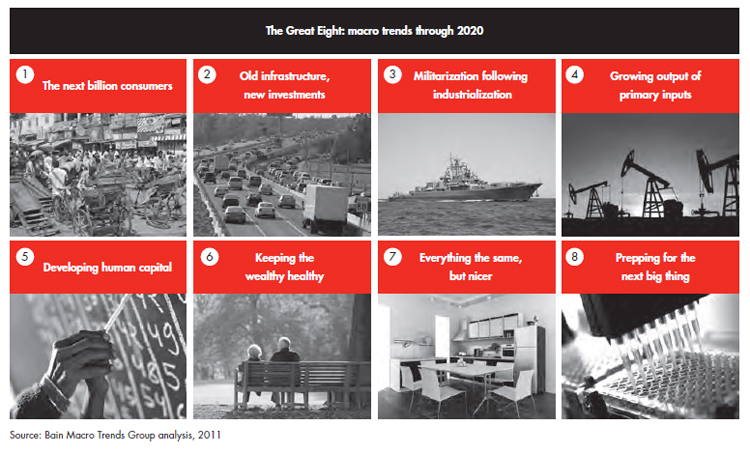
The Great Eight: Trillion Dollar Growth Trends
This is by Karen Harris, Austin Kim, Andrew Schwedel.
Lots of visuals
In true consulting form, there are lots of graphs, tables, charts and diagrams. It looks like 70%+ of the pages have some type of data visualization. It’s definitely a consultant’s bias, but if the data does not lend itself to some type of grouping or bucketing, your PowerPoint (or report in this case), is probably not saying anything new.
Waterfall charts
There are 5 waterfall charts in the report. They are everywhere. For those hearing that term for the first time, a waterfall chart is a fancy way of showing a lot of information in a graph that looks like a staircase. You have probably seen one in the past. They are great to use for income statements or anything that adds/subtracts to a subtotal.
Waterfall #1
This shows the 8 macro trends adding up to $27 trillion in growth over 10 years. More than half of that is from the developing economies (shown in dark gray).
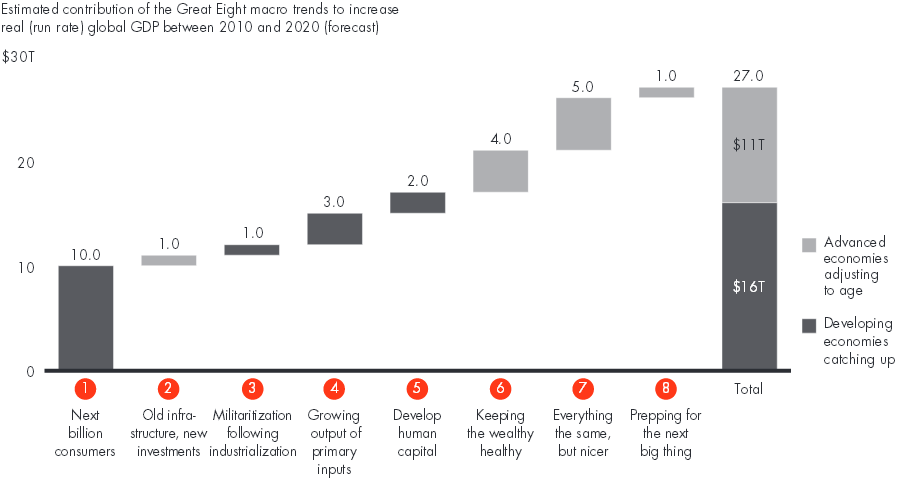
Waterfall chart #2
This one is pretty silly. It is saying 3.6 billion people + 1.3 billion people = 4.8 billion. Don’t need a waterfall chart to say that. Also, it’s unfortunate how the numbers round up/down funny and don’t add up. Ooops.
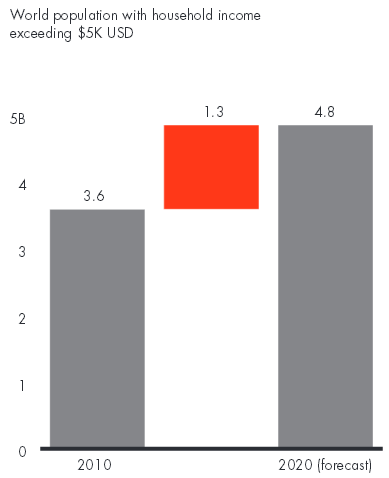
Waterfall chart #3
This shows how much incremental investment (above the current average run-rate) will happen in the utility sectors. Overall, it will be $625 billion. You’ll notice that telecom investment is actually negative $75 billion. It’s a nit-pick, but I would have used the red color to highlight the -$75 billion, which seems to be the point.
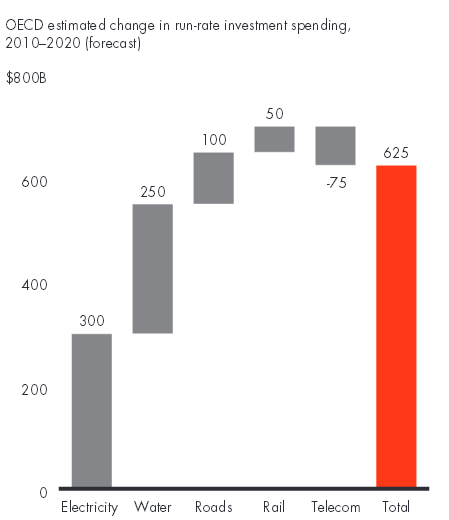
Waterfall chart #4
In this chart, Bain highlights the 5 buckets of incremental energy supply that are all fossil fuels. That fact might come as a surprise to people who think new energy will be solar, biomass, or otherwise.
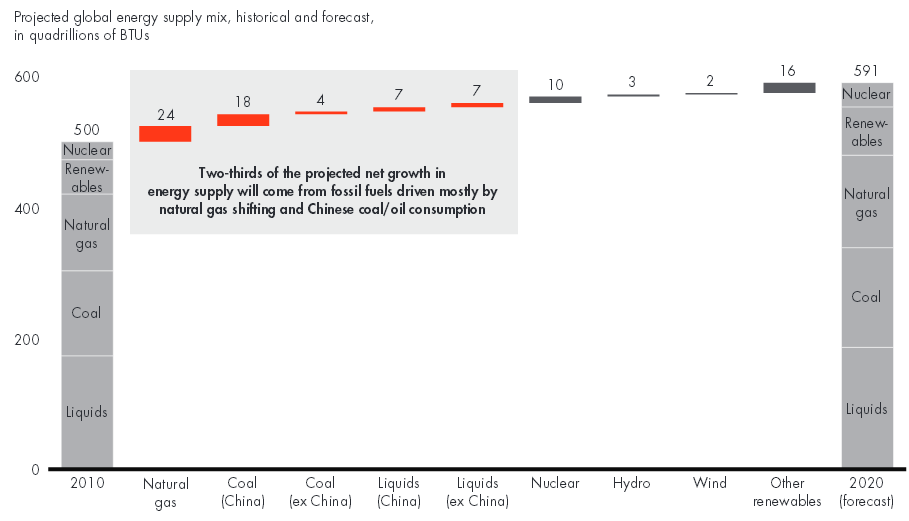
Waterfall chart #5
Fascinating chart. In 2010, US healthcare (shown in red) is about half of the whole world’s spending (even though only 330M out of 7,000M people). In the second column you see US healthcare spending increasing substantially, almost doubling by the of the decade. That compares negatively with Europe which keeps its costs in check.
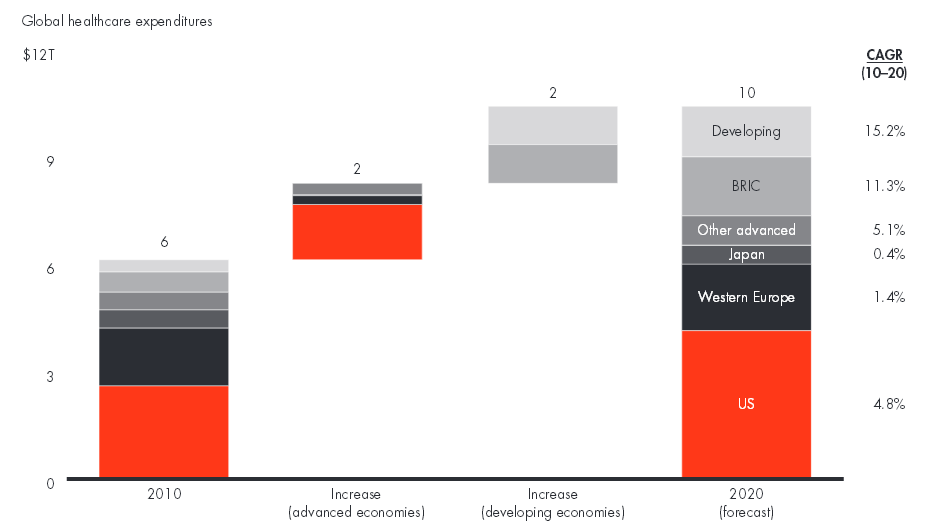
How to make a waterfall chart
There are several ways. Some analysts on my team might create complicated excels with macro functions. Don’t do that. Painful. You can go to a website called Waterfall-chart.com. You enter in the information. It creates a waterfall chart, then emails it to you in excel. I’ve tried it and it works fine.
My approach (admittedly old school, and perhaps a bit manual) is to create a bar-chart in excel and simply erase out all colors except for the blocks you want to highlight. It takes a little time, but it works. Apologies for ending this Bain research blog post with Chipotle, but I was getting hungry. From Revenues, I took out COGS, SG&A, and other costs to get to Chipotle’s 2012 annual income statement.
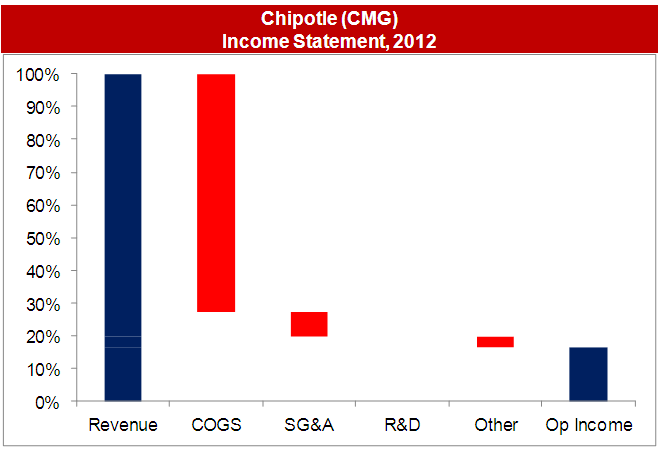

Hey there,
Great read – you nicely highlight the use (and over use) of the waterfall chart. I’d love to see a copy of the template if you could send it to me.
With thanks,
James
James, thanks for the compliment. Sent the excel to your email. Hope you find it helpful. Best,
Hello, Can you please share the excel template. Thanks
Hello, sent it your way.
Hey,
Fantastic post covering the different types of charts and the particular strengths of each. Working in a technical space I see far too many tables and not enough graphs; I would appreciate a copy of the template if you could send it through.
Thanks for the great blog,
Matt
Matt, thanks for the shout-out. Have a powerful week. Will send over the template.
Hello,
Great post! I’d love to see the template too. Keep up the great work, it’s not going unnoticed.
-Zola
Zola, thanks for the encouragement. Template headed your way.
Would love to have a copy of the template as well!
– Elvis
Elvis, sent your way. Hope it helps. Be good,
great explanation! i love your blog, have been perusing it for the last little bit; considering a career switch from risk management
would appreciate a copy of the template!
Allie, thanks for the encouragement. Will send it over.
good report. .. would appreciate if you can share a copy of the template!
Aravind, Sending your way. Have a great week.
great information I really appreciate if you can share a copy of the template!
Reply ↓
Victor, sending over. Have a powerful week.
Hi there,
Great post! Would really appreciate a copy of the template!
Thanks in advance 🙂
Sending your way.
I’d love to see a copy of the template, looks great!!
Will send your way by email. Thanks for reading.
Great blog, a true gem. Happy to have come across it. Would you be kind to share your template? Thanks in advance!
Thank you for reading. Will send over shortly.
Hi there,
I really enjoyed reading your posts. Please send a copy of the excel to me as well.
Thanks in advance.
– Keng Fai
Yes, will send to your gmail. Thank you for reading.
Wow! Still replying to comments 3+ years later.
Great overview and would love the excel data if you’re still sharing it.
Thanks.
-Josh
Surely. Sending over.
Your blog is a tressure trove to me. Reading every post since i came across. I would really appreciate to get the excel template as well.
Will send shortly. Thanks for reading. Keep trucking.
Great blog. As an evolving strategy consultant+mentor, always looking for great resources for people esp. outside of strategy (eg., digital designers).
I do waterfalls differently but would love to see your excel. Thanks!
Surely, sent.
Unrivaled blog and consulting expertise.My first choice for strategy and consulting reading. Thank you.
I would also appreciate if you could share the template.
Thanks for reading, will send to your email. Keep going.
My favorite blog, learning a lot about consulting. I would appreciate if you shared the excel template.
Yes, will send it over.
Just joined this blog and finding it really interesting, is the template still available?
Yes, will send by email. Thanks for reading.
Dear John,
can I have the template, too. Thank you so much.
Yes, will send over.
I realized the first comment was back in 2013. Having said that still very relevant content I must say. Big fan of your blog!
Do you mind sending through the template? Plan to add more waterfalls to my arsenal